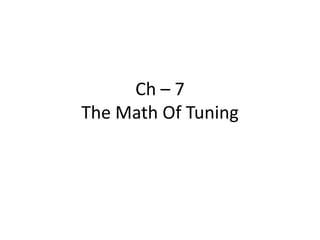Ch 7
- 1. Ch – 7 The Math Of Tuning
- 2. How Long Should My Test Run??? • The data rate (number of conversions per day) • Size of improvements found (Percentage Improvement) • Size of your test (Number of alternative designs) • The confidence in your answer ( How sure you need to be )
- 3. Data Rate • The data rate decribes how quickly you collect data during your test. • The volume of traffic for landing page optimization tests is best measured in the number of conversion actions per day ( and not the number of unique visitors). • You can decrease the size of the test. This can be done by decreasing the granularity of your test elements.
- 4. Size of Improvements Found • If you have managed to uncover a clearly superior version of your landing page, the performance improvement would quickly become apparent. • often, an initial round of changes will fix some of the obvious problems and improve performance significantly. • Since you do not know the size of the possible improvements ahead of tme, the length of the time required for the tuning test may vary signifantly.
- 5. Size of your Test • The size of your test can be measured by the size of the search space that you are considering. • The search space is the whole universe of the alternative designs possible in your test. • A simple head to head test has a search space size of 2 ( the originl, and the alternative landing page version that you are testing.) • If you are testing multiple elements on the page, you need to multiply together the number of alternative versions for each one.
- 6. Variable Interactions • When the setting for one variable in your test positively or negatively influences the setting of another variable is variable interaction. • If they have no effect then they are said to be independent. • In a positive interaction, 2 variables create a synergistic effect. • In a negative interaction, 2 variables undercut each other and cancel out some of the individual effects.












